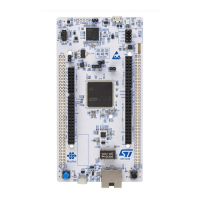Hardware layout and configuration UM2407
26/48 UM2407 Rev 1
NX3215SA-32.768kHZ-EXS00A-MU00525 (32.768 kHz, 6 pf load capacitance,
20 ppm) from NDK. The configuration must be:
– SB40 and SB41 OFF
– R38 and R39 ON
• Oscillator from external PC14: from external oscillator through the pin 25 of CN11
connector. The configuration must be:
– SB40 and SB41 ON
– R38 and R39 OFF
• LSE not used: PC14 and PC15 are used as GPIOs instead of low-speed clock. The
configuration must be:
– SB40 and SB41 ON
– R38 and R39 OFF
6.6 Board functions
6.6.1 LEDs
User LD1: a green user LED is connected to the STM32H7 I/O PB0 (SB39 ON and SB47
OFF) or PA5 (SB47 ON and SB39 OFF) corresponding to the ST Zio D13.
User LD2: a yellow user LED is connected to PE1.
User LD3: a red user LED is connected to PB14.
These user LEDs are on when the I/O is HIGH value, and are off when the I/O is LOW.
LD4 COM: the tricolor LED LD4 (green, orange, red) provides information about ST-LINK
communication status. LD4 default color is red. LD4 turns to green to indicate that
communication is in progress between the PC and the STLINK-V3, with the following setup:
• Slow blinking red/off: at power-on before USB initialization
• Fast blinking red/off: after the first correct communication between PC and
STLINK-V3 (enumeration)
• Red LED on: when the initialization between the PC and STLINK-V3 is complete
• Green LED on: after a successful target communication initialization
• Blinking red/green: during communication with target
• Green on: communication finished and successful
• Orange on: communication failure
LD5 PWR: the green LED indicates that the STM32H7 part is powered and +5 V power is
available on CN8 pin 9 and CN11 pin 18.
LD6 USB power fault: LD5 indicates that the board power consumption on USB exceeds
500
mA, consequently the user must power the board using an external power supply.
LD7 and LD8 USB FS: refer to Section 6.6.6: USB OTG FS.
6.6.2 Push-buttons
B1 USER (blue button): the user button is connected to the I/O PC13 by default (tamper
support, SB51 ON and SB58 OFF) or PA0 (Wakeup support, SB58 ON and SB51 OFF) of
the STM32H7 Series microcontroller.

